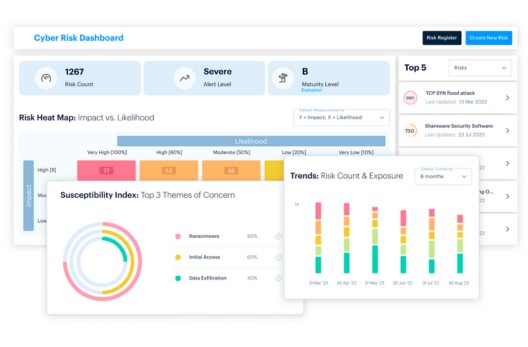Cloud Security • 10 MIN READ
6 Cloud Vulnerabilities to Look Out For in 2023
by Eleanor Barlow, Daksh Kaur • May 2023
Most companies are highly dependent on cloud hosting for storage and computing. As much as it helps as a central storage and processing unit, the cyber risks associated with Cloud are on the rise.
This blog discusses 6 key vulnerabilities to look out for in 2023, and ways to enhance your security posture.
What are Vulnerabilities in Cloud?
In cloud computing, vulnerabilities are referred to as oversight security loopholes that hackers can exploit to access, steal, or intercept confidential information about your business and/or employees. They may even encrypt files and demand a high ransom in exchange for the decryption key.
It’s to be noted that a vulnerability isn’t the same as a threat; often these terms are used interchangeably, which is technically wrong. A threat is an immediate danger that can cause severe consequences if not responded to in time. DDoS (Distributed Denial of Service) attack is one such threat where bad actors flood a network with malicious traffic, causing an online service to crash temporarily or permanently. A vulnerability, on the other hand, is a security weakness that can be taken advantage of, to gain unauthorized access.
6 Top Cloud Vulnerabilities to Look Out For in 2023
Misconfigured Cloud Storage
Cloud storage is a goldmine for cybercriminals looking for data. Once they steal your data, they either use it themselves for attacking your business or sell it on the dark web. Thus, reviewing your cloud storage configurations is an important security measure.
Some cloud storage platforms are set to ‘private’ by default while many aren’t. Ensure resetting to ‘private’ so that only trusted people can access sensitive information. It’s also advised to enable encryption while transferring data so hackers can’t intercept it.
Insecure APIs
An API or Application Programming Interface lets two unrelated software applications communicate with each other. Here, the term ‘interface’ is used for the contract of service between these two sets of software, which tells how the information will be exchanged.
For APIs to transfer data securely, they need to have access to sensitive software functions and data, which cybercriminals take advantage of. The use of tokens allows the exchange of information without the risk of exposing passwords.
All the APIs should undergo continuous asset discovery as a part of the vulnerability management exercise. This helps detect cloud vulnerabilities which you can remediate before it’s too late.
Poor Access Management
Access management, also called identity management, refers to the steps a user must take to access software and cloud applications. You can manage vulnerabilities in these steps by using multi-factor authentication, allowlisting, blocklisting, or the principle of least privilege.
Lately, cloud platforms require users to create strong and unique passwords including a certain character length, and a combination of uppercase letters, lowercase letters, special characters, and numbers.
Data Compliance and Privacy Concerns
Companies are subjected to data compliance and privacy laws which means they must stick to the regulatory standards of cloud computing applied to their industry of service. Some of the most well-known privacy regulations include the General Data Protection Regulation (GDPR), PCI Security Standards Council (PCI SSC), and California Consumer Privacy Act (CCPA).
As a user, you’re responsible for managing security controls. For example, if your password is weak or used across different accounts and it gets stolen, the cloud service provider isn’t at fault.
You must choose a cloud service provider that uses the best security tools to protect your data. Look for features like access management, intrusion detection and prevention, traffic monitoring, etc.
Account Hijacking
Account hijacking or session hijacking is when threat actors steal your accounts’ credentials. Some common techniques for attempting this are:
- Phishing: Hackers use social engineering tactics and send emails on behalf of reputed companies where they trick recipients into sharing personal details including passwords. Learn how you can detect phishing scams here.
- Keylogging: Software programs are used to track user activity, including login credentials. Data is then collected and sent back to cybercriminals.
- Brute Force Attack: Attackers use hit-and-trial methods to guess your passwords. That’s why it’s suggested not to set passwords that are easily guessable. For example, don’t use your pet’s name, street name, or favourite coffee shop. For more on password protection, read here.
- Cross-Site Scripting: In this technique, bad actors infect a system with malicious codes which are delivered through web browsers. These codes are designed to obtain access to unsecured accounts.
Malicious Insiders
Humans are the weakest security link. Employees, third-party vendors, and business partners can breach data or cause other cloud security issues knowingly or unknowingly. You need to establish strong policies against such acts to stay protected. Moreover, restricting access to critical files to only trusted people and conducting audits will help.
How to Manage Cloud Vulnerabilities?
Cloud vulnerabilities are ever emerging and managing them should be your priority.
There isn’t a one-size-fits-all solution to cybersecurity; you need to devise strategies as per your IT structure and vulnerability nature. Observe how your company’s risk posture changes, and alter your approach accordingly.
SecurityHQ’s vulnerability management service is designed to detect, classify, and contextualize vulnerabilities. With flexible patching days your operations aren’t disrupted.
To speak with an expert, contact the team here.












